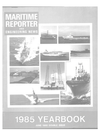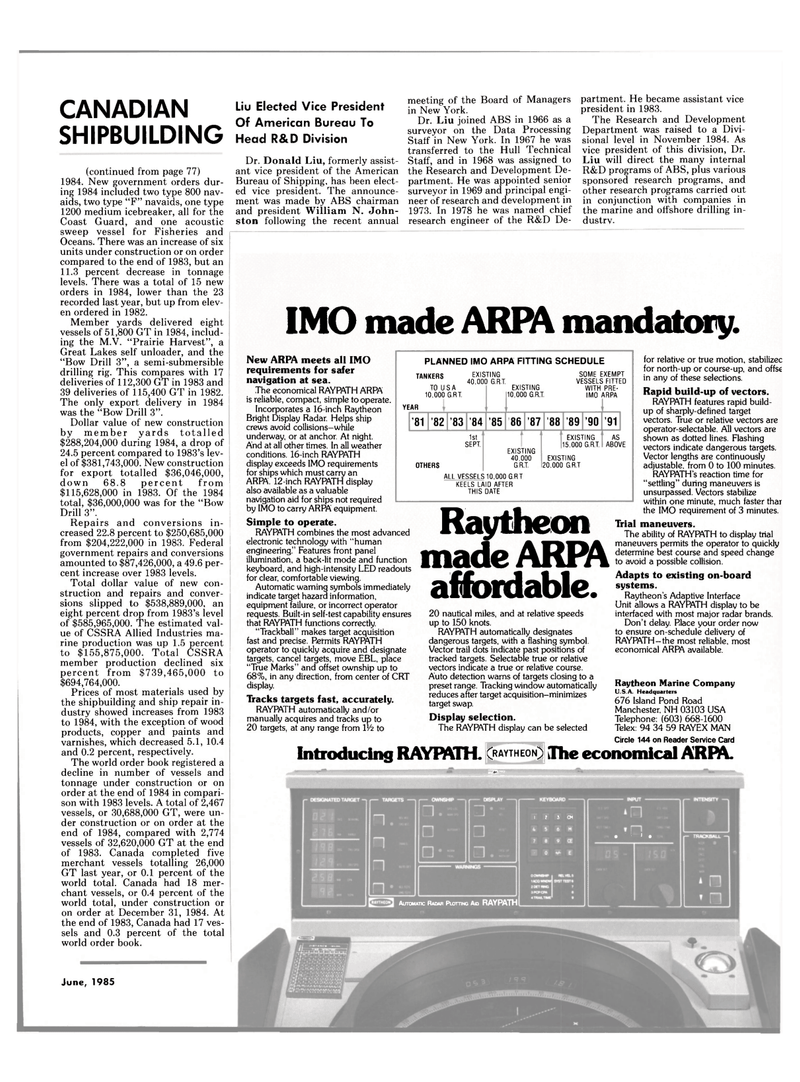
Page 81: of Maritime Reporter Magazine (June 1985)
Read this page in Pdf, Flash or Html5 edition of June 1985 Maritime Reporter Magazine
CANADIAN
SHIPBUILDING (continued from page 77) 1984. New government orders dur- ing 1984 included two type 800 nav- aids, two type "F" navaids, one type 1200 medium icebreaker, all for the
Coast Guard, and one acoustic sweep vessel for Fisheries and
Oceans. There was an increase of six units under construction or on order compared to the end of 1983, but an 11.3 percent decrease in tonnage levels. There was a total of 15 new orders in 1984, lower than the 23 recorded last year, but up from elev- en ordered in 1982.
Member yards delivered eight vessels of 51,800 GT in 1984, includ- ing the M.V. "Prairie Harvest", a
Great Lakes self unloader, and the "Bow Drill 3", a semi-submersible drilling rig. This compares with 17 deliveries of 112,300 GT in 1983 and 39 deliveries of 115,400 GT in 1982.
The only export delivery in 1984 was the "Bow Drill 3".
Dollar value of new construction by member yards totalled $288,204,000 during 1984, a drop of 24.5 percent compared to 1983's lev- el of $381,743,000. New construction for export totalled $36,046,000, down 68.8 percent from $115,628,000 in 1983. Of the 1984 total, $36,000,000 was for the "Bow
Drill 3".
Repairs and conversions in- creased 22.8 percent to $250,685,000 from $204,222,000 in 1983. Federal government repairs and conversions amounted to $87,426,000, a 49.6 per- cent increase over 1983 levels.
Total dollar value of new con- struction and repairs and conver- sions slipped to $538,889,000, an eight percent drop from 1983's level of $585,965,000. The estimated val- ue of CSSRA Allied Industries ma- rine production was up 1.5 percent to $155,875,000. Total CSSRA member production declined six percent from $739,465,000 to $694,764,000.
Prices of most materials used by the shipbuilding and ship repair in- dustry showed increases from 1983 to 1984, with the exception of wood products, copper and paints and varnishes, which decreased 5.1, 10.4 and 0.2 percent, respectively.
The world order book registered a decline in number of vessels and tonnage under construction or on order at the end of 1984 in compari- son with 1983 levels. A total of 2,467 vessels, or 30,688,000 GT, were un- der construction or on order at the end of 1984, compared with 2,774 vessels of 32,620,000 GT at the end of 1983. Canada completed five merchant vessels totalling 26,000
GT last year, or 0.1 percent of the world total. Canada had 18 mer- chant vessels, or 0.4 percent of the world total, under construction or on order at December 31, 1984. At the end of 1983, Canada had 17 ves- sels and 0.3 percent of the total world order book.
June, 1985
Liu Elected Vice President
Of American Bureau To
Head R&D Division
Dr. Donald Liu, formerly assist- ant vice president of the American
Bureau of Shipping, has been elect- ed vice president. The announce- ment was made by ABS chairman and president William N. John- ston following the recent annual meeting of the Board of Managers in New York.
Dr. Liu joined ABS in 1966 as a surveyor on the Data Processing
Staff in New York. In 1967 he was transferred to the Hull Technical
Staff, and in 1968 was assigned to the Research and Development De- partment. He was appointed senior surveyor in 1969 and principal engi- neer of research and development in 1973. In 1978 he was named chief research engineer of the R&D De- partment. He became assistant vice president in 1983.
The Research and Development
Department was raised to a Divi- sional level in November 1984. As vice president of this division, Dr.
Liu will direct the many internal
R&D programs of ABS, plus various sponsored research programs, and other research programs carried out in conjunction with companies in the marine and offshore drilling in- dustry.
IMO made ARPA mandatory.
YEAR
New ARPA meets all IMO requirements for safer navigation at sea.
The economical RAYPATH ARPA is reliable, compact, simple to operate.
Incorporates a 16-inch Raytheon
Bright Display Radar. Helps ship crews avoid collisions-while underway, or at anchor. At night.
And at all other times. In all weather conditions. 16-inch RAYPATH display exceeds IMO requirements for ships which must carry an
ARPA. 12-inch RAYPATH display also available as a valuable navigation aid for ships not required by IMO to carry ARPA equipment.
Simple to operate.
RAYPATH combines the most advanced electronic technology with "human engineering." Features front panel illumination, a back-lit mode and function keyboard, and high-intensity LED readouts for clear, comfortable viewing.
Automatic warning symbols immediately indicate target hazard information, equipment failure, or incorrect operator requests. Built-in self-test capability ensures that RAYPATH functions correctly. "Trackball" makes target acquisition fast and precise. Permits RAYPATH operator to quickly acquire and designate targets, cancel targets, move EBL, place "True Marks" and offset ownship up to 68%, in any direction, from center of CRT display.
Tracks targets fast, accurately.
RAYPATH automatically and/or manually acquires and tracks up to 20 targets, at any range from IV2 to
PLANNED IMO ARPA FITTING SCHEDULE
TANKERS
TO USA 10,000 G.RT.
EXISTING 40.000 G.R.T. '81 '82 '83 '84 1st
SEPT.
OTHERS '85
EXISTING 10,000 G.RT
SOME EXEMPT
VESSELS FITTED
WITH PRE-
IM0 ARPA 86 '87
EXISTING 40.000
G.RT '88 '89 '90
EXISTING 15.000 G.RT '91
AS
ABOVE
EXISTING 20.000 G.R.T
ALL VESSELS 10.000 G.RT
KEELS LAID AFTER
THIS DATE
Raythe made AI on
ARPA affordable. 20 nautical miles, and at relative speeds up to 150 knots.
RAYPATH automatically designates dangerous targets, with a flashing symbol.
Vector trail dots indicate past positions of tracked targets. Selectable true or relative vectors indicate a true or relative course.
Auto detection warns of targets closing to a preset range. Tracking window automatically reduces after target acquisition-minimizes target swap.
Display selection.
The RAYPATH display can be selected
Introducing RAYPATH. [Raytheon] The economical ARWV. for relative or true motion, stabilizec for north-up or course-up, and offs€ in any of these selections.
Rapid build-up of vectors.
RAYPATH features rapid build- up of sharply-defined target vectors. True or relative vectors are operator-selectable. All vectors are shown as dotted lines. Flashing vectors indicate dangerous targets.
Vector lengths are continuously adjustable, from 0 to 100 minutes.
RAYPATH's reaction time for "settling" during maneuvers is unsurpassed. Vectors stabilize within one minute, much faster thar the IMO requirement of 3 minutes.
Trial maneuvers.
The ability of RAYPATH to display trial maneuvers permits the operator to quickly determine best course and speed change to avoid a possible collision.
Adapts to existing on-board systems.
Raytheon's Adaptive Interface
Unit allows a RAYPATH display to be interfaced with most major radar brands.
Don't delay. Place your order now to ensure on-schedule delivery of
RAYPATH-the most reliable, most economical ARPA available.
Raytheon Marine Company
U.S.A. Headquarters 676 Island Pond Road
Manchester. NH 03103 USA
Telephone: (603) 668-1600
Telex: 94 34 59 RAYEX MAN
Circle 144 on Reader Service Card mm
I 2 3 CM
C„ • II.
AUTOMATIC RADAR PLOTTING AID RAYPATH

 80
80

 82
82
